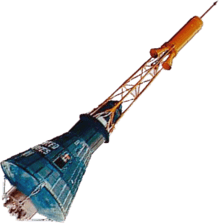Enos (chimpanzee)
Enos (d. November 4, 1962) was the second chimpanzee launched into space by NASA. He was the first and only chimpanzee, and third hominid after cosmonauts Yuri Gagarin and Gherman Titov, to achieve Earth orbit. Enos's flight occurred on November 29, 1961.[1]
.jpg) Enos, the only chimpanzee and third primate to orbit the Earth | |
| Species | Chimpanzee |
|---|---|
| Sex | Male |
| Died | November 4, 1962 |
| Employer | NASA |
| Notable role | First chimpanzee to achieve Earth orbit |
| Years active | 1960–1962 |


Enos was brought from the Miami Rare Bird Farm on April 3, 1960. He completed more than 1,250 training hours at the University of Kentucky and Holloman Air Force Base. Training was more intense for him than for his predecessor Ham, because Enos was exposed to weightlessness and higher gs for longer periods of time. His training included psychomotor instruction and aircraft flights.
Enos was selected for his Project Mercury flight only three days before launch. Two months prior, NASA launched Mercury Atlas 4 on September 13, 1961, to conduct an identical mission with a "crewman simulator" on board. Enos flew into space aboard Mercury Atlas 5 on November 29, 1961. He completed his first orbit in 1 hour and 28.5 minutes.[2]
Enos was scheduled to complete three orbits, but the mission was aborted after two due to two issues: capsule overheating and a malfunctioning "avoidance conditioning" test subjecting the primate to 76 electrical shocks.
The capsule was brought aboard USS Stormes in the late afternoon and Enos was immediately taken below deck by his Air Force handlers. Stormes arrived in Bermuda the next day.
Enos's flight was a full dress rehearsal for the next Mercury launch on February 20, 1962, which would make John Glenn the first American to orbit Earth, after astronauts Alan Shepard, Jr. and Gus Grissom's successful suborbital space flights.
On November 4, 1962, Enos died of shigellosis-related dysentery, which was resistant to then-known antibiotics. He was constantly observed for two months before his death. Pathologists reported no symptoms that could be attributed or related to his previous space flight. Many believe Enos's remains were dissected like Ham, who was extensively studied postmortem at the Armed Forces Institute of Pathology.
Some of Ham's remains, minus the skeleton (which remained with AIP), were buried at the International Space Hall of Fame in New Mexico. Later attempts by space scholars to locate Enos's remains were unsuccessful. A Post-mortem study was undertaken. His remains were then packed and sent to the Smithsonian Institution according to Dr. James E. Cook, Veterinary Pathologist, who was involved in Enos's autopsy and was also the Head of the Chimp Consortium at Holloman AFB at the time of Enos's death.
See also
- Monkeys and apes in space
- Little Joe 2 flight with Sam, Project Mercury rhesus monkey
- Ham, Project Mercury chimpanzee
- Animals in space
- One Small Step: The Story of the Space Chimps: (2008 documentary)
- Félicette: First cat in space
References
- "Operational Trouble Shortens Chimp's Ride". The Daily Advertiser. Lafayette, Louisiana. Associated Press. November 29, 1961. p. 1 – via Newspapers.com.
- Animals In Space: From Research Rockets to the Space Shuttle, Chris Dubbs and Colin Burgess, 2007
External links
| Wikimedia Commons has media related to Enos (Pan troglodytes). |
- Enos the Chimpanzee Travels to Space
- Voyage of space chimp Enos ended in Bermuda by Gail Westerfield
- A film clip Chimp into space (no title), 1961/11/30 (1961) is available at the Internet Archive
- A film clip documenting Enos take-off and landing is available at the Internet Archive
- One Small Step: The Story of the Space Chimps. Documentary on History of Primates Used in Space Travel
- Atlantic.com article about electrical shocks
- MentalFloss.com on 54th anniversary of flight
